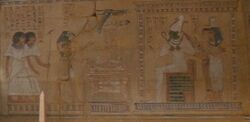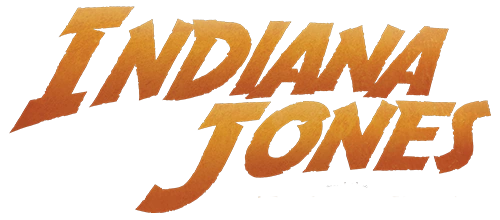Shishak, or Shishaq, was a 10th century BC Libyan pharaoh who ruled as one of the Tanite Kings of Lower Egypt.
Biography
Shishak was a descendant of a Libyan people from out of the western desert who had become Egyptian citizens and eventually rose up in prominence through positions in Egypt's military and bureaucracy. When the Twenty-First Dynasty pharaoh Psusennes II died in Bubastis without a male heir, Shishak claimed the throne of Lower Egypt while the priests of Thebes held Upper Egypt.[1]
Ruling from his captial city, Tanis, Pharoah Shishak sought the reunification of divided Egypt. To that end, several years into his reign, Shishak launched a military campaign against the Israelite kingdoms. Although relatively minor compared to the successes of his predecessors, the pharoah's war did briefly bolster the Egyptian economy and improve morale throughout the Nile Valley.[1]
Around 980 BC,[2] the king's armies – a force made up of 1200 chariots and 60,000 horsemen reinforced by countless men from Lubim, Sukkiim and Ethiopia according to the King James Bible – sacked the Hebrew capital, Jerusalem, during which the Temple of Solomon was raided of its treasures and brought back to Egypt including the Ark of the Covenant.[1]
During the subsequent months, Shishak's victories were celebrated. At distant Karnak, a new pylon gate with carved reliefs depicting the pharoah's battles was erected by enslaved Palestinian captives, and back at Tanis, Shishak had an obelisk commissioned which told the story of his campaign along with a new temple to honor his wardead, many of whom were entombed within.[1]
Shishak gave the Ark, a fabulous gold-gilded chest of great religious significance to the Hebrews with a history attached to it of misfortune befalling those who disturbed the relic, pride of place in the capital city, displaying his "greatest treasure" before the king's palace.[1]

Painting of Shishak as Horus with his two generals, the Ark of the Covenant, and Osiris, Isis, and Nephthys on Tanis' Map Room wall.
One night, however, Shishak had a dream: He presented the Ark to Osiris, the Egyptian god of the dead, who was pleased with the trophy captured from the Hebrew deity's temple, declaring that its golden radiance was comparable to that of the sun god, Amun-Ra, whose daily travels across the sky in his sun-barque illuminated the land. Yet when the barge arrived it was the Ark of the Covenant being ferried. Ra appeared and smote the vessel in two, sending the Ark tumbling into a city below and killing its inhabitants, the river drying and crops withering in its wake.[1]
Shishak demanded an explanation of the dream from his advisers. Unable to provide an answer, they turned to Userhet, the king's vizier (and probable high priest of Amun-Ra) who had cautioned against the Ark even being brought into Tanis. He informed Shishak that the pharaoh had Osiris' approval but the placement of the Ark before the palace was a direct challenge to the glory of Amun-Ra who would bring destruction upon the kingdom in his efforts to remove the Ark from his sight.[1]
Userhet recommended that the artifact should be hidden from the jealous god and so Shishak ordered the contruction of a shrine within a secret vault in the memorial temple called the Well of the Souls. There, four statues of Anubis, guardians of Osiris, would protect the golden Ark, placed in a stone sarcophagus, from ever again offending Ra. Shishak also followed Userhet's idea for building a special domed chapel within the Temple of Amun-Ra, a Map Room with a scale model of Tanis whereby the priests of Ra could use a staff topped by a headpiece to catch the sunlight through a portal in the dome every morning.[1] The mistrustful Amun-Ra could know the Ark's location without the need to ever look at it.[3]
Nevertheless, for all of Shishak's attempts to assuage divine intervention,[1] about one year after Shishak had returned to Egypt from the sack of Jerusalem, the entire city itself was buried in a yearlong sandstorm described as having been "wiped clean by the wrath of God."[2]
Legacy
Although nobody was left to record the disaster that had befallen Tanis and the exact location of the Ark of the Covenant was lost for hundreds of years, Shishak evidently had successors, with French archaeologist Pierre Montet uncovering the tomb of Shishak III during his extensive excavation of the site in the 20th century.[1]
The military campaign of Shishak was referenced in the Bible and on the pylon gate at Karnak. However, time would take its toll on the reliefs, leaving them in poor condition.[1]
Shishak's encounter with the Ark was also known to Indiana Jones and Marcus Brody who relayed it to Colonel Musgrove and Major Eaton, when, in 1936, the US intelligence agents approached them over Nazi interest at Tanis.[2]
Behind the scenes
The Biblical Shishak has been identified with the historical pharoah, Shoshenq I, and the Raiders of the Lost Ark Sourcebook states that Shishak succeeded Psusennes II as Shoshenq did. However, Shoshenq did not reign over Egypt in 980 BC. His rule came later in the century and Siamun (Psusennes' predecessor) was pharoah during the time Raiders of the Lost Ark attributes to Shishak.
Campbell Black's novelization of the film uses 926 BC instead, a more historically accurate date for Shoshenq's rule and closer to the time attributed to the Biblical Shishak's military conquest of the divided kingdoms of Israel in the aftermath of King Solomon's death. The Raiders Sourcebook has Shishak launch his campaign around 922 BC, "several years into his reign."
The ancient Libyans from whom Shishak is said to be a descendant likely refers to the Meshwesh – a lineage shared by Shoshenq – though no Indiana Jones source refers to them as such.
Appearances
- Raiders of the Lost Ark novel (Mentioned only)
- Raiders of the Lost Ark (Mentioned only)
- Indiana Jones and the Raiders of the Lost Ark (Mentioned only)
Sources
- Raiders of the Lost Ark Sourcebook
Ark of the Covenant on IndianaJones.com (backup link on Archive.org)
- Indiana Jones: The Ultimate Guide
- The Lost Journal of Indiana Jones
